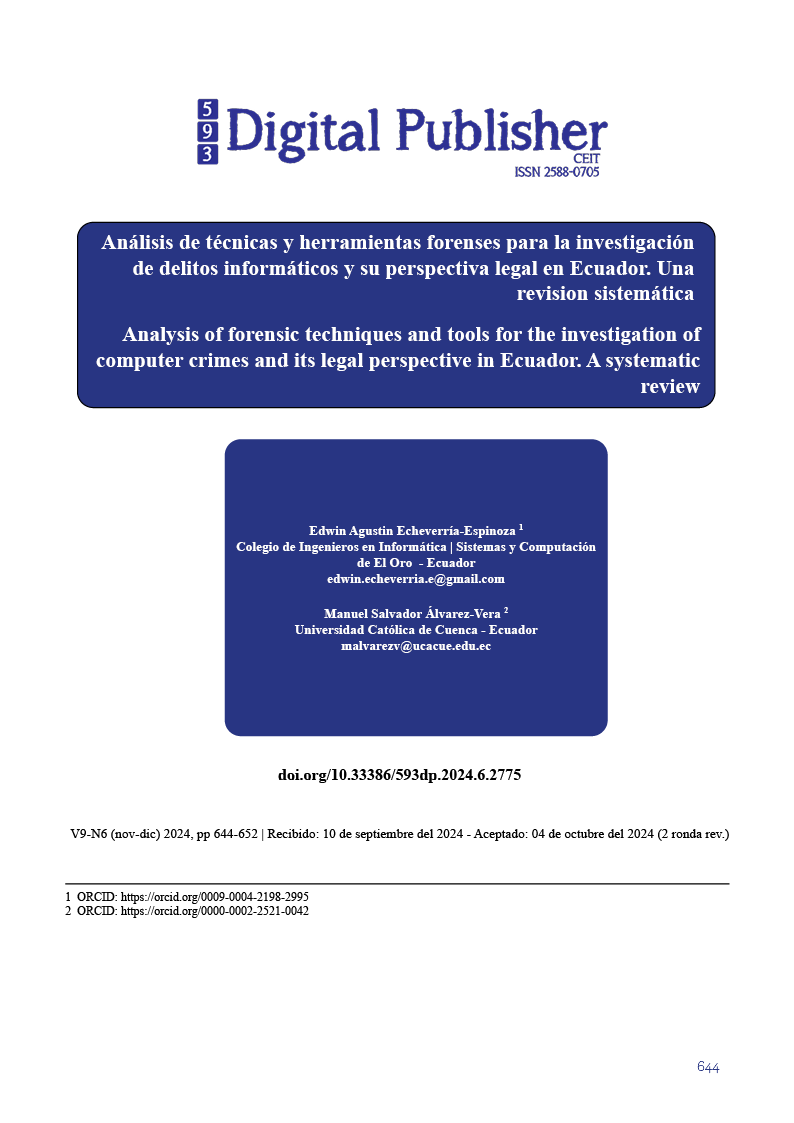Analysis of forensic techniques and tools for the investigation of computer crimes anf its legal perspective in Ecuador. A systematic review
Main Article Content
Abstract
The investigation of computer crimes in Ecuador has become a great challenge due to the increase in connectivity and sophistication of criminal techniques. In this context, computer forensics plays a crucial role in the identification, preservation and analysis of digital evidence to support the investigation of these crimes. The main objective of this article is to carry out an analysis of the forensic techniques and tools for the investigation of these crimes, as well as their legal aspects regarding the admissibility of digital evidence.
For this purpose, academic databases such as Scielo, Web of Science and Scopus were used, which included studies published in the last ten years. A variety of techniques and tools were identified including disk imaging, recovering deleted files, analyzing activity logs, and examining metadata. The most commonly used techniques include the Lockdown method, the Stratt method, and the GCII method, while the most common tools encompass both commercial and open-source software, such as EnCase, FTK, and X-Ways Forensics.
The investigation also revealed that Ecuadorian legislation provides a general legal framework for the investigation of computer crimes. However, there are significant challenges to the law in terms of its practical application, including the need for a more specific legal framework, training of forensic investigators, and the need to update standards to reflect technological advances.
Downloads
Article Details

This work is licensed under a Creative Commons Attribution-NonCommercial-ShareAlike 4.0 International License.
1. Derechos de autor
Las obras que se publican en 593 Digital Publisher CEIT están sujetas a los siguientes términos:
1.1. 593 Digital Publisher CEIT, conserva los derechos patrimoniales (copyright) de las obras publicadas, favorece y permite la reutilización de las mismas bajo la licencia Licencia Creative Commons 4.0 de Reconocimiento-NoComercial-CompartirIgual 4.0, por lo cual se pueden copiar, usar, difundir, transmitir y exponer públicamente, siempre que:
1.1.a. Se cite la autoría y fuente original de su publicación (revista, editorial, URL).
1.1.b. No se usen para fines comerciales u onerosos.
1.1.c. Se mencione la existencia y especificaciones de esta licencia de uso.
References
Asamblea Nacional, (10 de febrero de 2014). Código Integral Penal. Registro Oficial Suplemento 180. Quito, Quito, Ecuador.
Asociación Latinoamericana de Investigación en Criminalística y Ciencias Forenses: https://www.aicef.info/ Esta organización promueve la investigación y el desarrollo en el campo de la criminalística y las ciencias forenses en América Latina.
Aparicio, V(2021). Delitos informáticos en Ecuador según el COIP: un análisis documental. Recuperado de: https://orcid.org/0000-0002-1417-2036.
Corte Suprema de Justicia de Ecuador: https://www.cortenacional.gob.ec/ Este sitio web contiene información sobre el sistema legal ecuatoriano, incluyendo las leyes relacionadas con los delitos informáticos.
Espinoza, M. (2019). Informática forense: una revisión sistemática de la literatura. Rehuso, 4(2), 126-145. Recuperado de: https://doi.org/10.33936/rehuso.v4i2.1641
Informática forense: una revisión sistemática de la literatura (http://scielo.senescyt.gob.ec/) por Caviglione, Wendzel y Mazurczyk (2017). Este artículo proporciona una descripción general de las técnicas y herramientas forenses utilizadas en la investigación de delitos informáticos, y analiza su perspectiva legal en Ecuador.
Merve, O., İbrahim, K., & Hüseyin, Ç. (2016). General Evaluation and Requirement of Computer Forensics Education. Bilişim Teknolojileri Dergisi, Cilt, 9(2), 137-146. doi: 10.17671/btd.31631
Ramírez, R. (06 de 25 de 2017). policia.gob.ec. Obtenido de policia.gob.ec: https://www.policia.gob.ec/delitos-informaticos-establecidos-en-el-coip-y-como-prevenirlos/
Ramos-Torres C.A., Vieira, D. F., & Jacobovski, R. (2021). Estrutura institucional na avaliação e monitoramento de políticas públicas: uma análise nos países do MERCOSUL. Revista Brasileira de Administração Científica, 12(2), 232–245. https://doi.org/10.6008/cbpc2179-684x.2021.002.0019
Taborda, K. Branco, J., Cardoso, J., El uso de la informática en la pericia criminal y sus herramientas. Revista Espacios. Vol. 38, Año 2017. Número 51 Pág. 25 Recuperado de: ttp://www.revistaespacios.com/a17v38n51/a17v38n51p25.pdf
Vincze, E. A. (2016). Challenges in digital forensics. Police Practice and Research, 17(2), 183-194. doi: 10.1080/15614263.2015.1128163
Zambrano, K. I. D., & Ordoñez, L. M. M. (2016). Delito Informático. Procedimiento Penal en Ecuador. Dominio de las ciencias, 2(2), 204-215.



